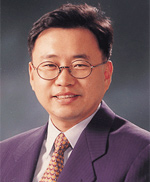 |
Yonsei University, KoreaSchool of Electrical and Electronic Engineering
|
Kwanghoon Sohn received the B.E. degree in electronics engineering from Yonsei University, Seoul , Korea in 1983, the MSEE degree in electrical engineering from University of Minnesota in 1985, and the Ph.D degree in electrical and computer engineering from North Carolina State University in 1992, respectively. He was employed as a senior member of research staff in the Satellite Communication Division at Electronics and Telecommunications Research Institute (ETRI), Daeduk Science Town, Korea, from 1992 to 1993. Also, he was employed as a post doctoral fellow at MRI Center in the Medial School of Georgetown University. He was a visiting professor of Nanyang Technological University in Singapore from 2002 to 2003 and a visiting scholar at Agency for Defense Development of Korea from 2009 to 2010. He is currently a professor of school of Electrical and Electronics Engineering at Yonsei University. His research interests include three dimensional image processing, computer vision and image communication. Dr. Sohn has published numerous research papers especially in the field of 3D video processing. He was invited as a invited speaker or a keynote speaker in the field of 3D video from many international conferences. He worked for the government as a member of Program Director in the division of Home Entertainment and Consumer Electronics as well as in the division of Broadcasting.
Next Generation Video Technology – 3D Video
In this lecture, I will overview 3D video related topics as a next generation video technology. I will introduce many important core techniques in 3D video acquisition, video processing and display and also talk about disparity estimation, intermediate view rendering techniques and their applications to 3D video. I will also briefly introduce 3D video coding issues including MPEG standard activity.
Currently, there are some bottleneck problems to be solved for successful commercialization of 3D video technology. I will discuss about them and introduce my current research results on visual fatigue from 3D video. I will investigate various factors that are related to visual fatigue caused by 3D video. In addition, I provide visual fatigue prediction metrics for stereoscopic videos and 2D-plus-depth video. The metric detects impairments caused by inappropriate shooting parameters and camera misalignment from corresponding points of stereoscopic image. It analyzes depth and motion characteristics for 2D-plus-depth video. The results can be applied to visual comfort enhancement.